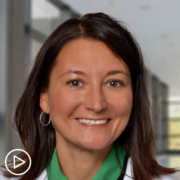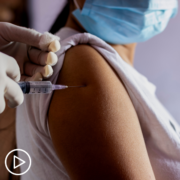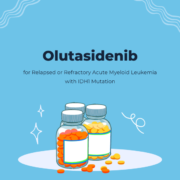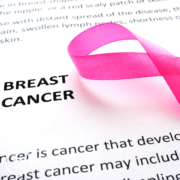Understanding DLBCL Treatment Classes
Understanding DLBCL Treatment Classes from Patient Empowerment Network on Vimeo.
Dr. Kami Maddocks reviews diffuse large B-cell lymphoma (DLBCL) treatment approaches, including options for patients who are considered high-risk or who have relapsed. Dr. Maddocks goes on to review which factors are considered when selecting a therapy and the potential for curative treatment.
Dr. Kami Maddocks is a hematologist who specializes in treating patients with B-cell malignancies at the The Ohio State University Comprehensive Cancer Center – The James. Learn more about Dr. Maddocks.
See More From The Pro-Active DLBCL Patient Toolkit
Related Programs:

|

|

|
Transcript:
Katherine:
Let’s turn to treatment options. Is a person with DLBCL treated right away?
Dr. Maddocks:
They’re treated pretty quickly after the diagnosis. So, typically, when somebody has a diagnosis, they undergo a number of different tests, including lab work, imaging work, sometimes for their biopsies.
So, that information is gathered over days to sometimes a few weeks process. Then, when you have all that information, you go over the results, go over the treatment at that time. So, it’s typically treated not within, usually, a day of diagnosis but it’s not something that you spend weeks or months before treating.
Katherine:
Yeah. What are the different types of treatments available?
Dr. Maddocks:
So, the diffuse large B-cell lymphoma is treated with chemotherapy and immunotherapy. So, a combination of an immune antibody therapy and chemotherapy. There is a role in some cases for radiation, but never just radiation alone and never just surgery alone. So, there’s always what we call a systemic treatment so, a treatment that goes everywhere. Because this is considered a blood cancer, it’s a cancer of those cells, it can really spread anywhere.
And so, just cutting it out with surgery or just radiating the area doesn’t treat everything, even if you can’t identify it.
Katherine:
Can you get specific about some of the treatment classes?
Dr. Maddocks:
Yeah. So, the most common treatment for diffuse large B-cell lymphoma is a chemo immunotherapy called R-CHOP. So, this is three chemotherapies and antibody therapy that’s direct called rituximab (Rituxan) that’s directed at a protein on the lymphoma cells. And then, a steroid called prednisone, given with the chemo and then for a few days after. There was a study that recently showed an improvement with switching one of those drugs with another immunotherapy that’s an antibody conjugated to a chemo drug. But that’s not yet been approved. There are clinical trials available. So, looking at these treatments that might be new or combining therapies with this standard treatment.
And then, very occasionally, there are certain features of diffuse large B-cell lymphoma. There are particular few different subtypes that are classified a little bit differently, that are treated within an infusional therapy called Dose Adjusted R-EPOCH.
Katherine:
What about stem cell therapy? Is that used?
Dr. Maddock:
Stem cell therapy is used in the relapse setting. So, if a patient doesn’t go into a remission or if they relapse after achieving a remission with their chemotherapy, then stem cell transplant is an option. So, there are actually two different types of stem cell transplant. One from yourself and one from somebody else. In lymphoma, we typically do one from yourself, where you donate your own cell before. But we don’t use that as part of the initial treatment.
Katherine:
So, if somebody is high risk, Dr. Maddocks, is the approach different for them?
Dr. Maddocks:
So, it depends. We define high risk in different ways. So, there’s a specific type of lymphoma called double hit lymphoma, where there’s a few chromosomal translocations associated with the lymphoma, that we give a little more aggressive chemo immunotherapy regimen. There are also other subtypes, including a rare type of lymphoma called primary mediastinal B-cell lymphoma. Again, categorized a little bit different but sometimes included as a large cell lymphoma. We also give that treatment for.
Katherine:
Okay. So, there’s a lot of different options available for people.
Dr. Maddocks:
Correct. And there’s always clinical trials. So, there’s always the option to find something where we’re studying some of these newer therapies. They’re therapies in combination.
Katherine:
Is a cure possible?
Dr. Maddocks:
Yes. A cure is possible. When you look at patients who are treated with initial chemotherapy, we cure somewhere between 60 percent to 70 percent of patients with the initial chemotherapy. If patients’ relapse, depending on their age and their condition, they’re candidates for other therapies.
And therapy including other chemo and stem cell transplant is potentially curable in some patients. And then, there’s a newer therapy called chimeric antigen receptor T-cell, or CAR T-cell therapy, which also looks like it’s curing a subset of patients who relapse or don’t respond to initial therapy.










